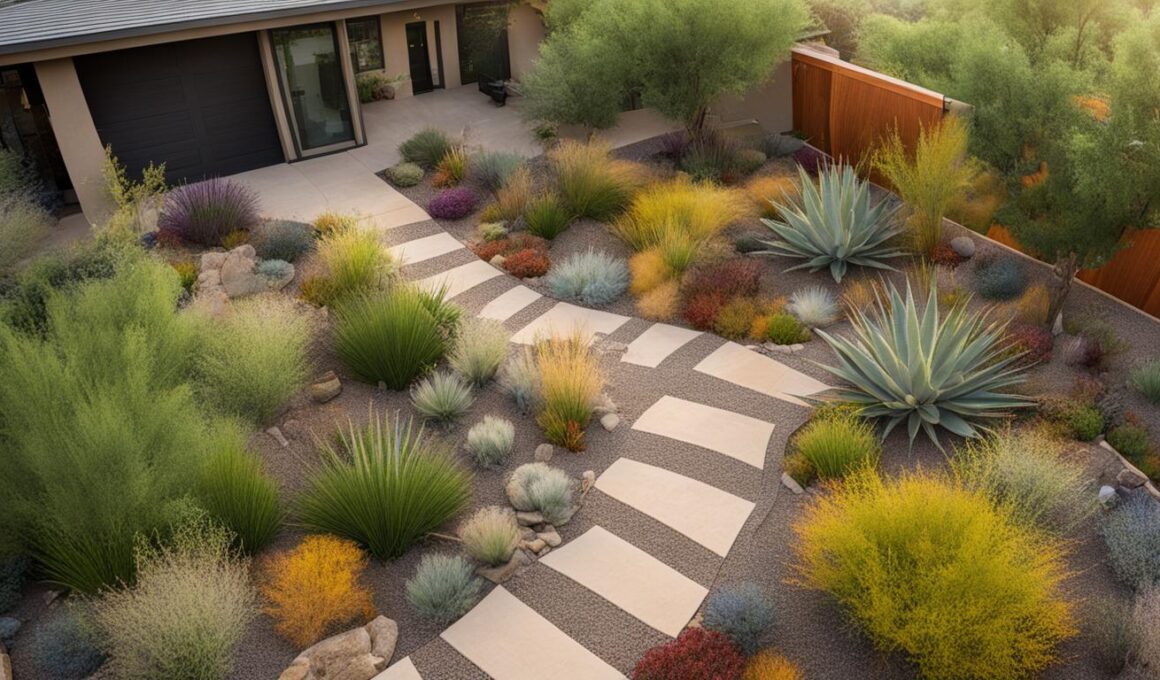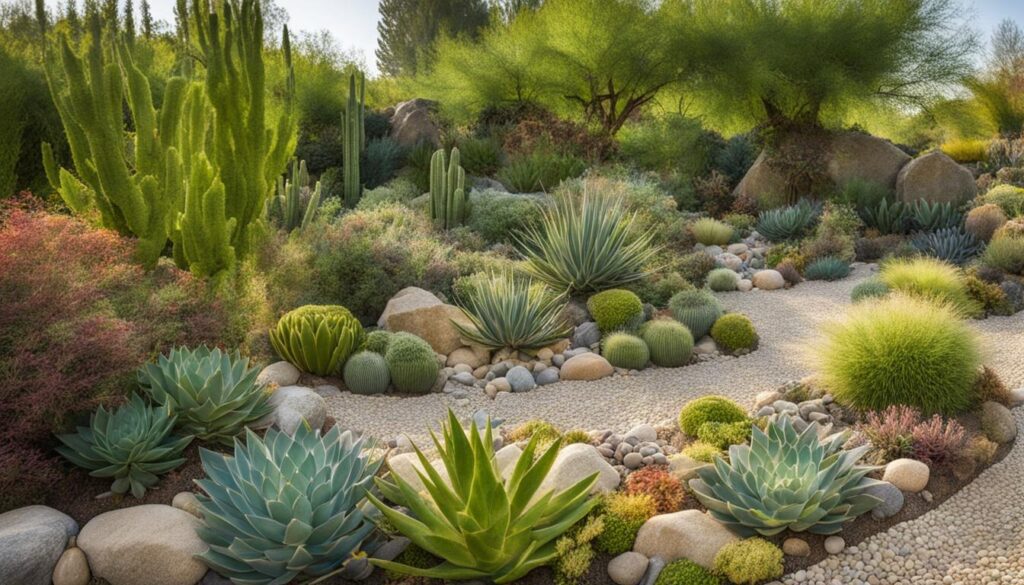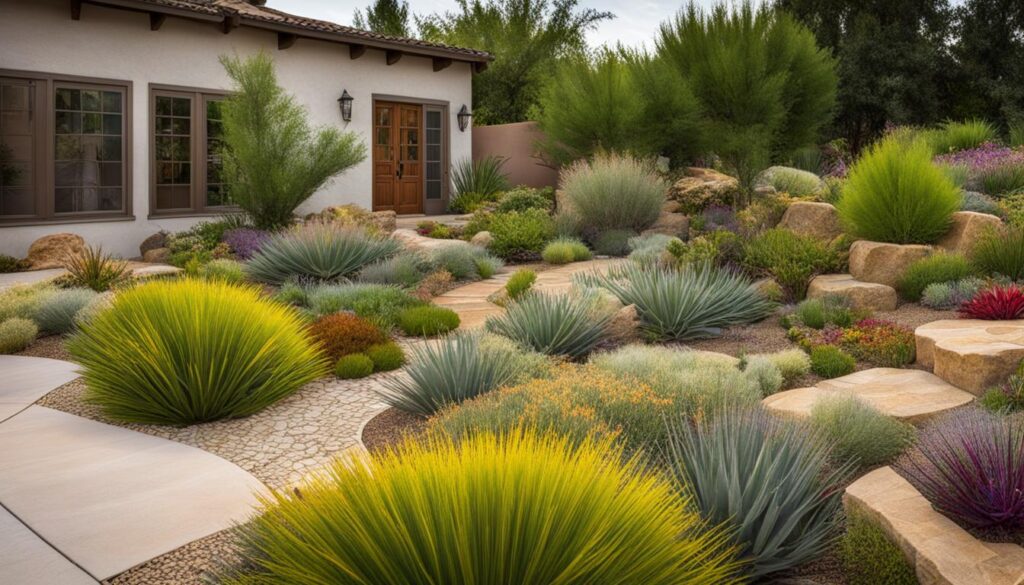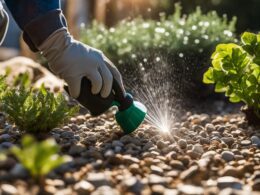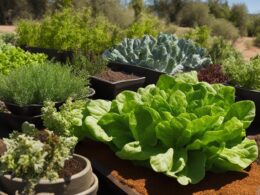Xeriscape gardening is a sustainable and water-efficient landscaping approach that can transform your yard into a beautiful oasis while conserving water. By carefully planning your xeriscape garden and selecting the right plants, you can create a low-maintenance landscape that thrives in arid and semi-arid regions. The following sections will guide you through the process of xeriscape garden planning and plant selection.
Key Takeaways:
- Xeriscape gardening is a sustainable and water-efficient landscaping approach.
- Careful planning and plant selection are crucial for creating a successful xeriscape garden.
- Xeriscape gardens thrive in arid and semi-arid regions.
- Low-maintenance landscaping is a key benefit of xeriscape gardening.
- Xeriscape gardens conserve water and contribute to a sustainable environment.
Choosing the Right Plants for Xeriscape Gardens
When creating a xeriscape garden, one of the most important considerations is choosing the right plants. Selecting species that are well-suited to arid conditions and require minimal water is essential for a successful and sustainable landscape. Native plants and drought-resistant species are excellent choices, as they have adapted to the local climate and are naturally more water-efficient.
Native plants are particularly advantageous for xeriscape gardens because they have evolved to thrive in the specific environmental conditions of a region. These plants are often more resistant to pests and diseases, reducing the need for chemical pesticides and fertilizers. Additionally, native plants provide habitat and food for local wildlife, contributing to a more balanced and diverse ecosystem.
Drought-resistant plants are another great option for xeriscape gardens. These species have adaptations that allow them to survive with minimal water. For example, many desert plants have extensive root systems that enable them to absorb moisture from deep within the soil. Others have waxy or hairy leaves that help reduce water loss through evaporation. By choosing drought-resistant plants, you can create a beautiful landscape that thrives even in dry conditions.
Understanding Plant Sizes and Container Sizes
When designing a xeriscape garden, it’s important to consider the sizes of the plants and containers you’ll be working with. Plant size and shape are crucial factors in creating a visually appealing landscape, while container sizes determine the initial space your plants will occupy. Understanding these aspects will help you make informed decisions in your xeriscape garden design.
Plant size plays a significant role in the overall aesthetic of your xeriscape garden. Different plants have varying mature heights and spreads, which can greatly impact the visual composition of your landscape. Some plants have a compact or upright growth habit, making them suitable for smaller spaces, while others may have a sprawling or spreading habit, requiring more room to grow. By considering the mature sizes of the plants you choose, you can strategically plan their placement to create a harmonious and balanced design.
Container sizes are also essential to consider when selecting plants for your xeriscape garden. The size of the container determines the initial root space available for your plants and can impact their growth and development. Generally, perennials come in 1 to 3-gallon containers, shrubs in 3 to 15-gallon containers, and trees in 15 to 100-gallon containers. By choosing plants that are suited to the appropriate container sizes, you can ensure they have enough space to establish healthy root systems and thrive in your xeriscape garden.
Cost Considerations for Xeriscape Plants
When creating a xeriscape garden, it’s important to consider the cost of plants as part of your budget. The price range for xeriscape plants can vary depending on their size and maturity. Smaller plants in smaller containers tend to be more affordable, while larger and more mature plants will have a higher price tag.
It’s essential to evaluate your budget and time frame for your garden’s establishment when deciding on the sizes of plants to purchase. If you’re working with a limited budget, consider starting with smaller plants and allowing them to grow and establish over time. This can be a more cost-effective approach, allowing you to gradually expand and enhance your xeriscape garden.
Keep in mind that the cost of plants is just one factor to consider. Choosing the right plants that are well-suited to your climate and require minimal water will also contribute to the overall success and cost-effectiveness of your xeriscape garden.
Factors to Consider when Evaluating Plant Cost:
- Maturity: Larger and more mature plants often have a higher price tag due to the additional time and resources required to grow them.
- Size: Smaller plants in smaller containers are typically more affordable and can be a budget-friendly option, especially if you have patience and are willing to wait for them to grow.
- Quantity: Purchasing a larger number of plants can add up quickly, so consider the quantity needed to fill your xeriscape garden and choose accordingly.
- Local Availability: Plants that are readily available in your area may be more affordable compared to those that need to be shipped from other regions.
“By evaluating your budget, considering plant size and maturity, and exploring local availability, you can create a xeriscape garden that is both beautiful and cost-effective.” – Xeriscape Gardening Experts
Remember, creating a xeriscape garden is a long-term investment that offers numerous benefits, including water conservation, lower maintenance, and a sustainable outdoor space. So, don’t be discouraged by the initial cost of plants. With careful planning and strategic plant selection, you can create a stunning xeriscape garden within your budget.
The Benefits of Xeriscaping
Xeriscaping offers numerous benefits beyond water conservation. By reducing evaporation and runoff, xeriscape gardens can help lower water bills and conserve this precious resource. With drought becoming more prevalent in many regions, xeriscaping is becoming an increasingly popular choice for homeowners looking to create beautiful, sustainable landscapes.
One of the key advantages of xeriscaping is its ability to save water. Traditional landscaping methods often require excessive amounts of water to keep plants healthy, resulting in wastage and higher water bills. Xeriscape gardens, on the other hand, are designed to use minimal water through the use of native plants and strategic irrigation systems. This not only reduces water consumption but also helps to alleviate the strain on local water supplies.
“Xeriscaping not only conserves water but also reduces maintenance requirements. Native and drought-resistant plants are well-adapted to the local climate, making them more resilient and less dependent on additional water, fertilizer, and pesticides.”
Another significant benefit of xeriscaping is its low maintenance requirements. Native and drought-resistant plants are well-adapted to the local climate, making them more resilient and less dependent on additional water, fertilizer, and pesticides. This means less time and effort spent on watering, mowing, and maintaining your garden, allowing you to enjoy a beautiful outdoor space with minimal upkeep.
In addition to water conservation and low maintenance, xeriscape gardens can provide habitat for local wildlife, create a more sustainable environment, and enhance the aesthetic appeal of your property. By incorporating xeriscaping principles into your landscape design, you can create a beautiful and eco-friendly space that not only benefits you but also contributes to a greener future.
Steps in Creating a Xeriscape Garden
Creating a xeriscape garden involves several important steps that will help you design and install a water-efficient and sustainable landscape. By following these steps, you can transform your yard into a beautiful and thriving xeriscape garden.
Determine Your Garden Design
The first step in creating a xeriscape garden is to determine your garden design. Consider factors such as the size and shape of your yard, as well as any existing features that you want to incorporate into your design. Think about the overall aesthetic you want to achieve and choose plant types that complement your vision.
Select Drought-Resistant Plants
Next, select drought-resistant plants that are well-suited to your climate. These plants require minimal water and can thrive in arid conditions. Choose a variety of plant species that offer different colors, textures, and heights to create visual interest in your garden. Native plants are a great option, as they are naturally adapted to the local climate and require less maintenance.
Remove Existing Turf and Consider Alternatives
If you have existing turf in your yard, consider removing it and replacing it with alternative plant options such as ground covers, gravel, or mulch. These alternatives require less water and maintenance than traditional grass lawns. Additionally, they can help reduce water runoff and improve soil moisture retention.
Implement Efficient Watering Techniques
Incorporate efficient watering techniques, such as drip irrigation, to minimize water usage in your xeriscape garden. Drip irrigation delivers water directly to the roots of plants, reducing evaporation and water waste. By strategically placing drip irrigation lines and using timers or moisture sensors, you can ensure that your plants receive the right amount of water without overwatering.
Map Out Plant Placement and Consider Mulching
Map out the placement of your plants based on their light and water requirements. Group plants with similar needs together to make watering more effective. Additionally, consider using mulch around your plants to reduce evaporation, suppress weed growth, and improve soil moisture retention. Organic mulches, such as wood chips or bark, can also contribute to the overall aesthetics of your xeriscape garden.
By following these steps in creating a xeriscape garden, you can design and install a water-efficient landscape that not only conserves water but also enhances the beauty of your outdoor space. Remember to choose plants that are well-suited to your climate, implement efficient watering techniques, and strategically plan the placement of your plants for maximum impact.
What Plants and Planning Tips Are Essential for Converting a Lawn to Xeriscape Garden?
When converting lawn to xeriscape, choose drought-tolerant plants like lavender, yarrow, and ornamental grasses. Plan strategic placement for optimal water conservation. Consider soil type and sun exposure. Incorporate mulch and efficient irrigation systems for successful xeriscaping. Research local xeriscape gardens for inspiration and practical tips.
Maintaining Your Xeriscape Garden
Now that you have created your beautiful xeriscape garden, it’s important to maintain it properly to ensure its long-term health and beauty. While xeriscape gardens are known for their low maintenance requirements, some upkeep is necessary to keep your plants thriving and your landscape looking its best.
Regular watering: While the water needs of xeriscape plants are minimal compared to traditional landscaping, they still require some watering. Monitor the moisture levels in your garden and water accordingly, focusing on the root zones of the plants. Consider using efficient watering techniques like drip irrigation to minimize water usage and prevent evaporation.
Pruning: Regular pruning helps maintain the shape and size of your plants, promotes healthy growth, and prevents overcrowding. Trim any dead or damaged branches, remove spent blooms, and prune back any overgrown foliage. This will not only keep your garden looking tidy but also encourage new growth.
Mulching: Applying a layer of mulch around your plants helps conserve moisture, suppresses weed growth, and regulates soil temperature. Use organic mulch, such as wood chips or straw, and apply it to a depth of 2-4 inches, avoiding direct contact with the plant stems. Mulching also adds aesthetic appeal to your garden and gives it a polished look.
By following these simple maintenance tasks, you can keep your xeriscape garden thriving and looking its best. Remember to stay attentive to the needs of your plants and make adjustments as necessary. With a little care and attention, your low-water landscaping will continue to flourish and provide you with a beautiful outdoor space to enjoy.
Conclusion
Xeriscape gardening is a smart and sustainable approach to landscaping that allows you to create a beautiful and water-efficient outdoor space. By carefully planning your garden, selecting drought-resistant plants, and implementing efficient watering techniques, you can enjoy a low-maintenance landscape that thrives in arid conditions.
To ensure the success of your xeriscape garden, here are a few important tips to keep in mind:
1. Choose the right plants:
Opt for native and drought-resistant plants that are well-suited to your local climate. These plants have adapted to survive in arid conditions and require less water to thrive.
2. Implement efficient watering techniques:
Consider using drip irrigation or other water-saving methods to minimize water usage and reduce evaporation. This will help conserve water while keeping your plants healthy.
3. Mulch and maintain:
Apply a layer of mulch around your plants to reduce evaporation, suppress weeds, and maintain soil moisture. Regularly prune and maintain your xeriscape garden to keep it looking vibrant and beautiful.
By following these xeriscape gardening tips, you can create a sustainable and water-efficient landscape that not only conserves water but also adds beauty and value to your outdoor space. Embrace the concept of xeriscaping and enjoy a more environmentally friendly approach to gardening.





